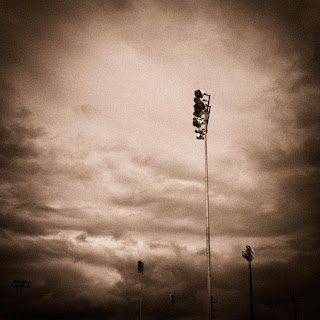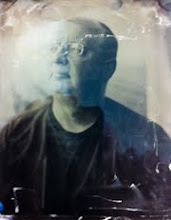Title: "Graveyard of Modern Totems"
(click to view larger)
I was reading a discussion about cliche images on a toy camera photography forum. The original poster was asking what cliches to avoid as he embarked on making images with his toy camera. There were several very thoughtful comments, one respondent advising him to look at lots of work by others.
While good advice, I think a few important points about looking at other work were missing. I personally think that one only gets a benefit from looking at other work with a critical/analytical eye. It's not enough to "know what you like" - it's very important to understand why an image works well. Learning this from other work informs your own work, and trains your eye to important elements like composition, tones, textures. As your eye gets trained in this way, it becomes important to apply that same critical/analytical look at your own work - so you can understand why some of your images work, and others don't. Look at your images from 6 months ago - do you still connect to them, and if so why? If some of your older images no longer seem so compelling, analyze why. This type of consideration of your work and that of other artists will provide numerous benefits.
I think the other missing piece of information about looking at the work of other artists is having a balance. Looking at "lots of work" must be balanced by making your own work and finding your own voice. If you place too much emphasis on looking at other work, you run the risk of becoming derivative, of making mediocre versions of work that others have made (or equally bad, making excellent "homage" pieces that have nothing of your own sensibilities incorporated). If some other artist's work appeals to you, think of ways you can take the process in a different direction, working on a theme or project to which you personally connect.
Today's image came about as I was walking around campus during my lunch break. I noticed the dramatic sky, and came upon the playing fields. The tight clustering of the fields means there is an accumulation of lighting standards. They are tightly grouped as if in conversation, but unlike the totems that appeared a couple of days ago, these modern versions have no story to tell, no myths to share.


2 comments:
I suspect that the intensity of that sky - the seemingly chaotic force of nature - helps communicate the lifeless (and so story-less) quality of the light standard totems. And I think that what you said about making art that is personally meaningful to you is so important. In terms of questions about cliche subjects, I don't think it's necessary to be a deconstructionist to acknowledge that it's all been done before. But each human being is unique, and if we can work from our personal meanings and/or emotional responses (rather than our ideas about others' expectations, for example), I imagine that will facilitate making unique works of art.
Jacki, I was thinking of your comment on that thread at toycam when I wrote about the need for making art that has personal meaning. Thank you for expanding on that idea so eloquently here.
Post a Comment